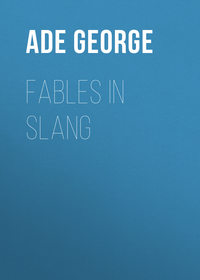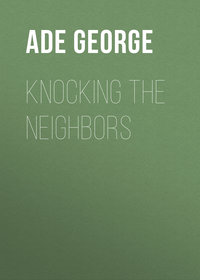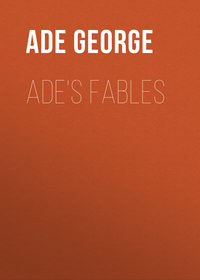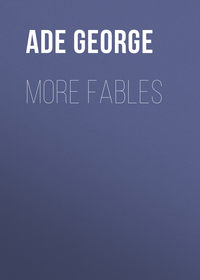 полная версия
полная версияIn Pastures New
We visited the pyramids. Also, we looked at the golf links, staked out across the barren sands – not to be played on, but merely to be featured in the hotel advertisement. Think of a golf course which is one huge hazard! Drive the ball in any direction and you can't play out of the sand! Forty centuries gazing down on a bow-legged tourist in fuzzy Scotch stockings!
Most of the pleasure seekers that we encountered in the neighbourhood of the Pyramids seemed to be quite elderly – some of the more sprightly as young as sixty, and from that going up to where it would be better to stop guessing. Mr. Peasley gave an explanation of their presence. He said that the dry climate of Egypt would preserve antiquities for an indefinite period.
Here they were, these male and female octogenarians, not propped up in arm chairs dividing the family silverware and arranging bequests to hospitals and libraries, but out on the blinding desert, thousands of miles from home, falling off donkeys, climbing up on camels, devouring guide books, rummaging around for time tables, kicking on the charges, and leading on the whole a life of purple strenuosity. We heard of two English women, sisters, both over seventy, who had just returned from Khartoum, from which point they had gone on a hunting expedition still further into the interior. They had to wear mosquito bags and semi-male attire, and were out in the wild country for days at a time, chasing gazelles, hyenas, and other indigenous fauna.
Just as I am about to conclude this treatise it occurs to me that, although I have given a wealth of useful information regarding the Pyramids, I have rather overlooked our old friend the Sphinx. I can only say in passing that it looks exactly like the printed advertisements. There is no deception about it. It is in a bad state of repair, but this is not surprising when we consider its age. Herodotus does not mention the Sphinx. It was right there at the time. In fact, it had been there fourteen hundred years when he first arrived. It seems strange that an observing traveller should have overlooked a monument sixty-six feet high, with a face nearly fourteen feet wide, a nose five feet and seven inches long, and wearing a smile that measures over seven feet! Herodotus either walked by without seeing it or else he did not think it worthy of mention. The only plausible explanation is that he was too busy figuring up the garlic statistics.
ON THE NILE
CHAPTER XIV
DASHING UP THE NILE IN COMPANY WITH MR. PEASLEY AND OTHERS
The dream of many years has come true. We are moving (southward) up the Nile. Like busy sand flies we are flitting, almost daily, across white patches of desert to burrow into second-hand tombs and crick our necks looking up at mutilated temples.
Ten years ago not one of us had ever heard of Koti or Khnemhotep. Now we refer to them in the most casual way, as if we had roomed with them for a while. It is certainly a gay life we are leading over the cemetery circuit. Just think what rollicking fun it must be to revel day after day in sarcophagi and sepulchres, stumbling through subterranean passages and kicking up the dust of departed kings, peering down into mummy pits, also trying to stretch the imagination like a rubber band so that we may get the full significance of what is meant by 1500 B.C. People come to Egypt to cure nervous depression and then spend nine-tenths of their time hanging around tombs. Why come all the way to Egypt? Why not go out to Woodlawn and run foot races from one family vault to another?
Mr. Peasley has no use for the tombs we have seen up to date. At Beni-Hassan we rode on donkeys and climbed hills for half an hour to inspect several large cubes of dim atmosphere surrounded by limestone. At Assiut we put in the best part of the afternoon toiling up to another gloomy cavern. While we stood in the main chamber of the tomb of Hapzefai (whoever he was), trying to pump up some enthusiasm, Mr. Peasley mopped his brow and declared himself.
"I'll tell you what I can do," he said. "I can take a hundred pounds of dynamite and a gang of dagoes and go anywhere along the Hudson and blow out a tomb in a week's time that will beat anything we've seen in Egypt. Then I'll hire a boy with a markin' brush to draw some one-legged men and some tall women with their heads turned the wrong way, and I'll charge six dollars to go in, and make my fortune."
The significance of the "six dollars" is that every traveller who wishes to visit the antiquities must pay a government tax of 120 piastres. He receives a "monument ticket," which he must show to the guard before entering any tomb or temple. I regret to say that the tickets are often passed along by departing travellers to those newly arrived, and as the guards do not read English, anything that looks like a monument ticket will satisfy the man at the door. At Beni-Hassan Mr. Peasley discovered, when he arrived at the tombs, that he had left his ticket at the boat. Fortunately, a fellow traveller had an extra ticket with him and Mr. Peasley had no difficulty in gaining admission to all the tombs under the name of "Miss Ella McPherson."
Before plunging into the details of our voyage, it is only fair that the indulgent reader should know how and why we came boating up the Nile. And first of all he should know something about this wonderful river. The Nile has been described one million times, at a rough guess, and yet at the risk of dealing out superfluous information I am going to insert some geography.
Total length, nearly four thousand miles. For thousands and thousands of years it has supported a swarming population along its banks, and yet until fifty years ago no one knew from whence it came. The inhabitants suspected that it came from somewhere, but they were too busy paying taxes and building pyramids to worry about scientific discoveries. For 1200 miles up stream from the delta outlet the Nile does not receive any tributary. It winds over a limestone base and through a rainless desert between high and barren tablelands. Occasionally, where there is a granite formation, the stream is narrowed and forces its way through rushing rapids, and these are known as the "cataracts." The first of these is at Assouan, about six hundred miles up stream.
Assouan has for many centuries marked the border line of Egypt proper. To the south is the land of the warlike blacks, who have been trouble-makers from the beginning of time. This First Cataract is the usual terminus of tourist travel, but those who wish to see Nubia and the Soudan board a small steamer, pass through the locks of the new dam, and go by river 210 miles to Wadi Halfa, thence by rail 576 miles to Khartoum. It is here, about thirteen hundred and fifty miles up stream, that the White and Blue Niles converge and bring down from the rainy equatorial regions the floods of muddy water which are the annual salvation of Egypt.
Ten years ago Khartoum seemed as inaccessible as the North Pole. It was headquarters for the most desperate swarm of frenzied fanatics that ever swept a region with fire and sword. They had wiped out British armies and put Gordon's head on a pole. They were in a drunken ecstasy of Mohammedan zeal, eager to fight and ready to die, and they got all that they were looking for.
It is less than eight years since Kitchener went down to call on them. Of all the cold-blooded and frozen-featured military tacticians of the inexorable school, Kitchener stands pre-eminent. General Grant in his grimmest moment was absolutely emotional and acrobatic as compared with Kitchener. He carried ice water in his veins, and his mental machinery ticked with Birmingham regularity. He did not get excited and dash into the open trap, as all the others had done. He moved slowly but relentlessly into the dread country and built a railroad as he went along. He carried everything that a British army needs – marmalade, polo ponies, Belfast ginger ale, tinned meats, pipe clay, etc.
"We cannot stampede them, because stampeding is their specialty," said Kitchener, "but I will lick them by algebra."
He did not say this, because he never said anything, but this is what he indicated by his calm preparations. He knew that the dervishes were frothing at the mouth and praying Allah to give them another chance to swim in gore, so he simply edged up to within striking distance of them and picked out his ground and waited. A kinetoscope hero would have galloped up and down the line shouting, "Up, men, and at them!" But Kitchener was not a hero. He was business manager of an abattoir. His object was not to win a great battle, but to exterminate a species. And he probably did one of the neatest jobs of house cleaning on record.
The bloodthirsty mob, led by the Khalifa, as principal maniac, charged across an open plain. Each determined dervish carried in his right hand a six foot spear, with which he hoped to do considerable damage. When he still lacked about a mile of being within poking distance of the hated infidel, the machine guns opened up and began to sweep the plain back and forth in long regular swaths, just as the sickle sweeps through the yellow grain. It was quite a handicap for the invincible children of Allah. They could not use their six foot spears on anyone a mile away, and before they could recover from the chagrin occasioned by this unexpected move on the part of the enemy, about eleven thousand of them had winged their way to eternal happiness and the others were radiating in all directions, pursued by those who wished to civilise them and bring them under British control. Those of the dervishes who escaped are supposed to be still running. At least they never came back to start another Messiah movement.
Ten years ago the Soudan was sealed to the whole world and death waited for the unbeliever who crossed the border. To-day the table d'hôte roams unafraid, and the illustrated post card blooms even as the rose.
The Nile of which you have read and along which are scattered the simon pure monuments of antiquity is the six hundred miles of winding river between Assouan, or First Cataract, and the sea. For the entire distance, until it spreads into a fan-shaped delta and filters into the Mediterranean, the stream is walled in by flat-topped hills of barren aspect. They are capped with limestone and carpeted about with shifting sands, and they look for all the world like the mesas of New Mexico and Arizona, for they lie baking in the same kind of clarified sunshine. This meandering hollow between the rugged hill ranges is the Valley of the Nile. Here and there the hills close in until the river banks are high and chalky cliffs. At one point the valley spreads to a width of thirty-three miles.
East and west of the hills are vast areas of desert without even a spear of vegetation except where there is a miraculous rise of water to the surface. These spots are grateful landmarks of clustered palms and are known as oases.
The Valley of the Nile would be just as bare and monotonous as an asphalt pavement were it not for the fact that once a year the Nile overflows. It has been overflowing every year for thousands of years, bringing down from the mountains of Abyssinia and the far-away regions of tropical rains a spreading volume of muddy water. Every winter, when the dwindling stream gets back into the customary bed, it has left a layer of black sediment over the inundated district. So many layers of sediment have been deposited that now the rich black soil is thirty to fifty feet deep along the river, thinning out as it meets the slope of the desert. Unlike our prairie soil of the Middle West, the Nile farms are not underlaid with clay. The Nile soil is black all the way down to limestone – a floury mineral powder of even composition. The only parts of Egypt which can be cultivated are those touched by the annual overflow. Egypt is really a ribbon of alluvial soil following the stream on either side. The tourist standing on the top deck of a Nile steamer can see both east and west the raw and broken edges of the desert.
The entire population lives on the river, literally and figuratively. Dark-robed women come down to the stream in endless processions to fill their water jars, and it seems that about every forty feet or so all the way up from Cairo the industrious fellah is lifting water up the bank and irrigating his little field with the same old-fashioned sweep and bucket arrangement that was in use when Joseph came over to Egypt and attracted the attention of Potiphar's wife. The Egyptian farmer is called a fellah. The clothing that he wears would wad a gun – that is, a rifle, not a shotgun. He puts in at least fourteen hours a day and his pay is from ten to fifteen cents. Mr. Peasley told a tourist the other day that the song "He's a jolly good fellah" originated in Egypt during the time of the Ptolemies. This is a sample of the kind of idiotic observation that is supposed to enliven a so-called pleasure trip.
But let us get back to the river, for in Egypt one must get back to the river at least once every twenty minutes. The Nile is Egypt and Egypt is the Nile. All this description may sound like a few pages from the trusty red guide book, and yet the word "Egypt" will have no meaning to the reader who does not get a clear panoramic vision of this wonderfully slim-waisted country. Nearly six hundred miles long and yet containing only twelve thousand five hundred square miles – about the size of Maryland.
The strip of black land which yields the plentiful crops is nowhere more than ten miles wide, a mere fringe of fertility weaving along through dryness and desolation. Anywhere along the river if you will climb to the rocky plateau, you will see the slow moving river, probably a half-mile wide, as a glassy thread on which are strung fields of living green, bordered by the dreary uplifts of desert. The traveller who goes by boat from Cairo to Assouan sees all of Egypt. The cities and temples and tombs of olden times were perched on the high spots or planted in the bare hills, so as to be safe from the annual rise of waters. Anything worth seeing in the whole country is within an easy donkey ride of the river bank. The river is the only artery of travel. There is a railway, but it follows the river all the way up to Assouan.
It would seem that the country was especially laid out and punctuated with "sights" for the convenience of the modern traveller, for the visitor who goes up the Nile and stops off at the right spots can do a clean job of sight seeing without doubling on his tracks.
Until a few years age the tourist going up the Nile had to take a dahabeah. This sounds like the name of a disease, but it is really a big, roomy, flat-bottomed sailboat. The dahabeah moves only when the wind is in the right direction, and to go from Cairo to Assouan requires the greater part of a lifetime. Those travellers who have money to burn and who are content to settle down to many weeks of rest and indolence charter the private dahabeahs. When a traveller goes aboard a dahabeah he tears up the calendar and lets his watch run down. Those who have more money and are in a hurry use the private steam dahabeahs.
A majority of travellers go by passenger boats. The tourist steamers devote three weeks to a loafing voyage up to Assouan and back, with daily excursions to the graveyards and ruins. The express steamers, carrying freight and native passengers, take less time for the round trip, as they skip some of the less interesting antiquities. We took an express steamer, thereby missing many of the tombs and temples, but still getting enough of them to last us for the next hundred years or so.
Our steamer is a frail affair, double decked and of no draught worth mentioning. It resembles the old style of Missouri River boat, built to run on a heavy dew. There are thirty passengers, who devote most of their time to lolling on deck waiting for the next meal. Mud banks, natives hoisting water, green fields stretching away to the bald range of hills, 'dobe huts, spindly palms, now and then a solemn row of camels, always several donkeys and goats in evidence, every few miles the tall stack of a sugar mill, perpetual sunshine – it is monotonous travel, and yet there is continually something doing along the banks, and the traveller cannot get away from that feeling of satisfaction which results from lying back to watch other people work.
And the sunsets! You cannot estimate the real dignity and artistic value of a camel until you see him or her silhouetted against a sky of molten gold just at twilight. I have made two or three attempts to describe the glory of a sunset in the desert, but I find myself as helpless as Mr. Peasley, who, after gazing for five minutes at the flaming horizon can only murmur a low but reverent "Gosh!"
It may interest the reader to hear what Baedeker has to say on the subject. Baedeker says (p. 216) "The sunsets are very fine." That's what I like about Baedeker. He doesn't fuss over a lot of words and tack on superfluous adjectives. As soon as he has imparted the necessary information in a trim and concise manner he moves on to the next subject.
I am sending herewith two sketches which show the beauty and variety of landscape to which we are treated every day. View No. 1 is most characteristic. We see before us the rippling Nile and beyond it the sheer river bank of black dirt. Then the field of waving grain, in the distance the range of hills, and over all a dazzling sunshine.
No. 2 is more varied. Again we have the river, the mud bank, and the growing crops, together with the distant hills, behind which the sun is silently sinking. In the foreground at the left is a majestic palm. The structure at the right is a native house and will indicate something of the simple life of the agriculturist. The complicated device on the river bank at stage centre is the shadouf, used for lifting water from the stream. The cavernous opening in the distant hill (marked X in the drawing) is the entrance to a rock tomb. By studying this picture the reader may get a very fair understanding of the architectural splendour of these ancient sepulchres.
Travelling on the Nile has two reliable features to commend it. The weather is always fair and the native population constantly enlivens the picture, for the lower river is crowded with sails and every inch along the banks is under cultivation. Also, the Nile has some surprises in store. Two definite delusions are soon shattered.
Delusion No. 1. – HEAT. It is not always warm in Egypt. In the middle of the day, out of the wind and on the desert, it may work up to a good summery temperature at this season, but in the shade it is cool, and as soon as the sun has set, a bracing autumnal chill comes into the air and the heavy overcoat is needed. The north wind can be very chiselly at times. If coming to Egypt, bring your flannels along.
Delusion No. 2. – CROCODILES. There are no crocodiles in the Nile. We have always supposed that the bank of the river was polka-dotted with these monsters, lying in wait for small, dark children. It is said that two thousand years ago the Nile was bordered with papyrus reeds or bullrushes, within the tangles of which lurked hippopotami, crocodiles, dragomans, and other reptiles, but the animals have disappeared, and so has the river vegetation. The other day we visited the island on which Pharaoh's daughter discovered little Moses. The island is still there, but there isn't a bullrush within a mile of it.
One of the penalties of travel is to have old and settled beliefs uprooted. For instance, there are no Maltese cats in Malta, no Venetian blinds in Venice, no Roman punch in Rome. If you want Neapolitan ice cream in Naples you must send out for it. You may walk about all day in Bologna without seeing a pound of Bologna sausage. Egyptian cigarettes are known throughout the world, and yet no tobacco is grown in Egypt. Go to Manhattan Beach and everybody is drinking Martinis. Truly, the stereotyped labels are deceptive.
CHAPTER XV
DAY BY DAY ON THE DROWSY NILE. WITH
SOMETHING ABOUT THE WONDERFUL HASSIM
While we were in London we dined one evening at a gorgeous hotel with a Mr. Brewster, of Connecticut. After dinner, Mr. Peasley told the waiter to bring some "good cigars." Mr. Peasley resides in Iowa, where it is customary to stroll down to the drug store after supper and buy a couple of Lottie Lees, which are so good that the druggist cannot afford to give six for a quarter. Not being familiar with the favourite brands of London, he called on Mr. Brewster to name the cigar of his choice, and Mr. Brewster said he was very fond of the Corona del Matadora, or something like that, because the entire crop in Cuba was taken over by a London dealer, and they could not be obtained in New York for love or money. The waiter brought what appeared to be a very superior article of stogie, and after they had been passed around, Mr. Peasley put several into his pockets, as we were going to a music hall, and Mr. Peasley had learned that tobacco acted as a sedative and helped one to remain calm while listening to British jokes.
"How much?" he asked.
"Three and six," replied the waiter.
Mr. Peasley handed him three and six.
"Each," said the waiter.
Mr. Peasley swallowed something and his eyes leaned from their sockets, but he said nothing. He handed over two sovereigns, and the change that came back to him was almost sufficient for the waiter's tip. There was a brief silence and then Mr. Peasley said: – "Three shillings is seventy-five cents – seventy-five and twelve make eighty-seven."
Another silence.
"Eighty-seven cents," sighed Mr. Peasley. "Three bushels of oats for a cigar!"
When Mr. Brewster crossed our trail in Egypt and became our fellow passenger on a Nile steamer Mr. Peasley remembered him and longed for a chance to get even.
Our friend from Connecticut was wearing a large canopy helmet – the kind that makes a short man look like a walking piano-stool. We were wearing the same outlandish style of headgear and for some reason or other, no person being responsible for what he does when he is away from home, Mr. Peasley had his name boldly marked in Arabic on the front of his helmet. It didn't look like anything, but it was real Arabic and said his name was Peasley and that he came from Iowa and he was very proud of it. He urged Mr. Brewster to have his helmet marked in a similar way.
"I hardly like the idea of wearing my name on my hat," said the man from Connecticut.
"But when you get home and hang the thing up in your den with the Navajo blankets and swords and other curios, think what a fine souvenir it will be," urged Mr. Peasley.
Mr. Brewster finally consented and Mr. Peasley took the helmet to the head steward, who was a native, and in a few minutes he brought it back magnificently lettered all over the front. It surely did look Oriental and decorative and Mr. Brewster was grateful when he saw how beautifully his name and New England address showed up in Arabic.
That afternoon we landed at Assiut, which is headquarters for a most wolfish assortment of guides, street peddlers, and hold-up men who work in the bazaars. Most of them are Copts and claim to be good Christians, but we did not feel impelled to throw up our hats on that account. When they bore down upon us and started to wrestle with us we could hardly distinguish any difference between them and the ordinary heathen.
From the moment that we landed, Mr. Brewster of Connecticut attracted more attention than any other person in the party. Four guides laid hold of him at the same moment and declined to let go. Later on, in the bazaar, every dealer who sighted him gave a glad guttural cry and tried to drag him into one of the stuffy little shops. The arrival of an ordinary tourist is calculated to agitate a bazaar, but when Mr. Brewster appeared the general effect was the same as when the raw meat is carried into the zoo. He was pulled and hauled and for the whole length of the winding bazaar his way was blocked by frantic villains in white gowns and huge turbans, who dangled tawdry merchandise in front of him and begged him to make an offer. Mr. Brewster was a good deal amazed, and we were more or less puzzled until we came back to the boat and Mr. Peasley confessed that the Arabic characters boldly displayed on Mr. Brewster's helmet did not stand for his name and address at all, but meant, as nearly as could be translated, "Rich American – Easy Mark."






